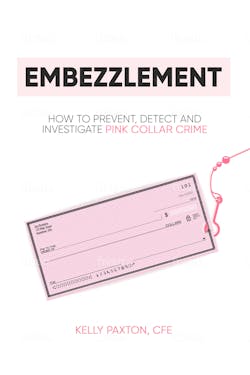One of the most common legal problems that we see in the fire service is embezzlement from volunteer fire departments and career firefighter unions. In studying these cases, I was shocked by both the frequency of their occurrence and the factual similarities.
Following the publication of one of my articles that mentioned data that show that treasurers were statistically the most likely to steal from a volunteer fire department, Kelly Paxton reached out to me. Paxton is a fraud examiner whose career has had a number of interesting twists and turns. She started in private industry, became a federal law enforcement agent, then worked for local law enforcement and now is back in private industry, helping businesses to recognize, investigate and prevent insider theft.
Paxton asked me a question that I did not have an answer to: Who was doing the embezzling from volunteer fire companies, men or women? My assumption was that the perpetrators of embezzlement reflected the fire service and were overwhelmingly male, but I had no data.
‘Trust’ that it happens
Paxton’s question sent me back to the digital woodshed to reanalyze several hundred theft cases that were in my database at the time. The results were rather sobering: More than one-third of those who stole from volunteer fire companies were women. When we consider the fact that, at best, women constitute 10 percent of the fire service, the number is even more unsettling. How did I miss that? Was it because of my own bias that assumed men were less trustworthy than women?
My results were not surprising to Paxton, nor was my bias. The results of her investigations over the years of the larger scope of the world indicate that women are just as likely as men to commit these types of offenses. However, for reasons that include a bias in favor of trusting women, the crimes of women often slip under the radar. Her politically incorrect conclusion gave rise to Paxton’s focus: pink-collar crime.
Paxton and I have become friends, and we routinely share information. In 2020, Paxton published her book, which is entitled “Embezzlement: How to Detect, Prevent and Investigate Pink-Collar Crime.” The book chronicles cases that she worked as well as others that she studied. From the case of a bookkeeper who stole $800,000, to the circumstance in which a finance manager stole more than $4.5 million, the book exposes how pink-collar theft flourishes at least in part because of a paradox that’s associated with trust. To quote Paxton, “Embezzlement is everywhere there is trust.”
Paxton distinguishes white-collar criminals, such as Bernie Madoff, who are overwhelmingly male, from pink-collar criminals, who are overwhelmingly, but not exclusively, female. As Paxton explains, pink-collar crime is more about the socio-economic status of women compared with men. White-collar criminals often are company presidents, chief executive officers and business owners; pink-collar criminals commonly are bookkeepers, office managers, administrative assistants and secretaries.
Commit to protections
Paxton’s book is a must-read for those who are in the position of responsibility for the financial security of their organization, whether it be a volunteer fire department or a career firefighter union. Both of these entities share a common vulnerability: an overreliance on the trust of colleagues. Trust can cause a person to ignore the need for safeguards that would help to ensure that theft does not occur or that would discover theft immediately if it does.
The book is full of valuable tips for implementing responsible financial checks and balances that are needed to prevent pink-collar theft. Paxton points to the convergence of three factors that she refers to as the fraud triangle: opportunity, pressure and rationalization. It explains how and why this kind of theft occurs. It also explains how to use the fraud triangle to help to identify at-risk individuals.
Pink-collar criminals typically are more patient and less prone to make large moves that might garner attention. This factor alone makes spotting their crimes more difficult. Numerous case studies explain how thieves exploited people’s trust, stole large sums over extended periods of time and concealed their misdeeds for years, even decades.
Staying one step ahead of an embezzler requires insight into the embezzler’s mind. Paxton’s book offers that insight from the intellect of someone who has devoted her life to the study.
I found the book to be an easy and interesting read, and I firmly believe that it is well worth the time of anyone who is concerned about organizational insider theft to take in what it has to offer.






